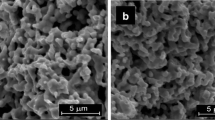Abstract
The thermodynamic and kinetic stability of Pr2−xNdxNiO4+δ was evaluated by thermogravimetry (TG) under a varying oxygen partial pressure (P(O2)). This study was performed because Pr2−xNdxNiO4+δ has been anticipated as the new cathode material for solid oxide fuel cells. It was found that Pr2NiO4+δ decomposed to a mixture of PrO1.83 and Pr4Ni3O10+δ at a P(O2) of 1 atm above 750 °C. For specimens with x ≤ 0.5, similar decomposition was observed above 750 °C; however, this decomposition was not observed for specimens with x ≥ 0.75. Regeneration of Pr2−xNdxNiO4+δ from the decomposed species was observed as an abrupt mass loss in TG curves for x = 0.0–0.5 at a higher temperature; this could be regarded as the approximate equilibrium temperature for the decomposition reaction. Using the approximate equilibrium temperature under the examined P(O2), thermodynamically stable P(O2) and temperature region of Pr2NiO4+δ was clarified and represented using a van’t Hoff plot. It was revealed that the thermodynamically stable region expanded only slightly with the partial substitution of Nd at the Pr site. Reaction kinetics of the decomposition was evaluated by isothermal TG at various P(O2). With decreasing P(O2) or increasing Nd content, kinetic stability of Pr2−xNdxNiO4+δ significantly improved; this was in good agreement with the observation of no decomposition for specimens with x ≥ 0.75. A higher activation energy was observed for decomposition kinetics in the Nd substituted specimen than that obtained by solely decreasing P(O2); this indicated that Nd substitution was more effective in preventing oxidation of Pr, which induced decomposition.













Similar content being viewed by others
References
Ishihara T. Oxide ion conductivity in defect perovskite, Pr2NiO4 and its application for solid oxide fuel cells. J Ceram Soc Jpn. 2014;122:179–86.
Lalane C, Mauvy F, Siebert E, Fontaine ML, Bassat JM, Ansart F, Stevens P, Grenier JC. Intermediate temperature SOFC single cell test using Nd1.95NiO4+δ as cathode. J Eur Ceram Soc. 2007;27:4195–8.
Mauvy F, Lalane C, Bassat JM, Grenier JC, Zhao H, Dordor P, Stevens Ph. Oxygen reduction on porous Ln2NiO4+δ electrodes. J Eur Ceram Soc. 2005;25:2669–72.
Boehm E, Bassat JM, Dordor P, Mauvy F, Grenier JC, Stevens Ph. Oxygen diffusion and transport properties in non-stoichiometric Ln2-xNiO4+δ oxides. Solid State Ion. 2005;176:2717–25.
Ogier T, Mauvy F, Bassat JM, Laurencin J, Mougin J, Grenier JC. Overstoichiometric oxides Ln2NiO4+δ (Ln=La, Pr or Nd) as oxygen anodic electrodes for solid oxide electrolysis application. Inter J Hydrogen Energy. 2015;40:15885–92.
Chauveau F, Mougin J, Bassat JM, Mauvy F, Grenier JC. A new anode material for solid oxide electrolyser: the neodymium nickelate Nd2NiO4+δ. J Power Sour. 2010;195:744–9.
Zhou XD, Templeton JW, Nie Z, Chen H, Stevenson JW, Pederson LR. Electrochemical performance and stability of the cathode for solid oxide fuel cells: V. High performance and stable Pr2NiO4 as the cathode for solid oxide fuel cells. Electrochim Acta. 2012;71:44–9.
Dogdibegovic E, Templeton J, Yan J, Stevenson JW, Zhou XD. Compatibility of praseodymium nickelate with various cathode current collectors and electrolytes. ECS Trans. 2013;57:1761–70.
Dogdibegovic E, Cai Q, Alabri NS, Guan W, Zhou XD. Activity and stability of (Pr1-xNdx)2NiO4 as cathodes for solid oxide fuel cells: III. Crystal structure, electrical properties, and microstructural analysis. J Electrochem Soc. 2017;164:F99–106.
Odier P, Allançon Ch, Bassat JM. Oxygen exchange in Pr2NiO4+δ at high temperature and direct formation of Pr4Ni3O10-x. J Solid State Chem. 2000;153:381–5.
Sullivan JD, Buttrey DJ, Cox DE, Hriljac J. A conventional and high-resolution synchrotron X-ray diffraction study of phase separations in Pr2NiO4+δ. J Solid State Chem. 1991;84:337–51.
Ning D, Baki A, Scherb T, Song J, Fantin A, Liu X, Schumacher G, Banhart J, Bouwmeester HJM. Influence of A-site deficiency on structure evolution of Pr2-xNiO4+δ with temperature. Solid State Ion. 2019;342:115056.
Broux T, Prestipino C, Bahout M, Paofai S, Elkaim E, Vibhu V, Grenier JC, Rougier A, Bassat JM, Hernandez O. Structure and reactivity with oxygen of Pr2NiO4+δ: an in situ synchrotron X-ray diffraction study. Dalton Trans. 2016;45:3024–33.
Murata A, Hai C, Matsuda M. Cathode property and thermal stability of Pr and Nd mixed Ni-based Ruddlesden–popper oxide for low-temperature operating solid oxide fuel cell. Mater Lett. 2014;136:292–4.
Montenegro-Hernández A, Vega-Castillo J, Caneiro A, Mogni L. High temperature orthorhombic/tetragonal transition and oxygen content of Pr2-xNdxNiO4+δ (x= 0, 0.3, 1, 1.7 and 2) solid solutions. J Solid State Chem. 2019;276:210–6.
Jander W. Reaktionen im festen Zustande bei höheren Temperature. Z Anorg Allg Chem. 1927;163:1–30.
Shannon RD. A revised effective ionic radii and systematic studies of interatomic distances in halides and chalcogenides. Acta Crystallogr. 1976;32:751–67.
Montenegro-Hernández A, Vega-Castillo JE, Caneiro A, Mogni L. Effect of neodymium doping on oxygen reduction activity in Pr2-xNdxNiO4+δ cathodes. Solid State Ion. https://doi.org/10.1016/j.ssi.2019.115093.
Acknowledgements
A part of this study was financially supported by the Nihon University President Grant Initiative. We would like to thank Editage (www.editage.com) for English language editing.
Author information
Authors and Affiliations
Corresponding author
Additional information
Publisher's Note
Springer Nature remains neutral with regard to jurisdictional claims in published maps and institutional affiliations.
Rights and permissions
About this article
Cite this article
Sakai, M., Wang, C., Okiba, T. et al. Evaluation of stability of Pr2−xNdxNiO4+δ by thermogravimetry under various oxygen partial pressures. J Therm Anal Calorim 142, 139–147 (2020). https://doi.org/10.1007/s10973-019-09190-9
Received:
Accepted:
Published:
Issue Date:
DOI: https://doi.org/10.1007/s10973-019-09190-9




